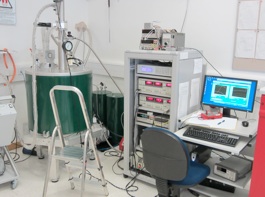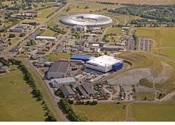
Ultra-sound is a powerful directional probe for understanding magnetic phase transitions and exploring non-conventional superconductivity. The project will develop and use this technique to gain insight into the mechanism responsible for unconventional superconductivity in UGe2 and similar materials. UGe2 is both ferromagentic and superconducting, a state requiring parallel spins to be paired.
Both the sound velocity and attenuation give information about the magnetic and electronic degrees of freedom. The technique is also well suited for use in pressure cells, needed to tune materials to the conditions where non-conventional superconductivity and other states emerge (at 1.2 GPa for UGe2). We have made ultrasound measurements up to 1.5 GPa and down to 2 K in high magnetic field to study a mysterious pressure induced magnetic transition that changes dramatically with pressure as the conditions for superconductivity are approached. The PhD project would extend this work to use our dilution refrigerator to study the superconducting phase in UGe2 at lower temperture. A prototype apparatus with an indentor cell allowing measurements on other systems requiring higher pressures would also be developed. The project offers the opportunity to work with state of the art instrument development and pressure cells to discover what drives superconductivity in ferromagentic superconductors. (Supervisors Profs Huxley and Kamenev).

Vortices are topologically protected stable structures. In type II superconductors they allow magentic flux to penetrate in multiples of the flux quantum. One of the holy grails of current research into exotic types of superconductivity is to discover materials that support half-quantum vortices. This requires odd-parity superconductivity that has an extra degree of freedom represented by a vector d that is free to rotate (physically the direction of d gives the direction along which the spin of the Cooper pairs in an odd parity superconducting state is zero). Such Vortices are expected to have interesting quantum statistics that may be harnessed to build a quantum computer that is topologically protected from decoherence. The project would look for such states in carefully selected candidate materials. To get these forms of superconductivity the materials have to be extremely pure and novel apparatus for SSE (solid state electrotransport) will be used to acheive this. One of the materials that we are currently investigating shows interesting magnetic properties related to geometric frustration and low dimensionality. The next stage and the goal of the project is to see if we indeed find superconductivity under pressure or if something else happens. The low-temperature properties of this and other candidate materials will then be characterised to determine the symmetry of the superconducting order parameter to assess whether it might support 1/2 quantum vortices. Finally attempts would be made to detect 1/2 quanta vortices in mesoscopic samples. The project will be centred on low temperature measurements but also involve growing single crystals and some experiments at central facilities to characterise magnetic structures and excitations. (Supervisor Prof Huxley).
In some magnetic materials, the topology of the lattice creates a situation where conventional magnetic phase transitions are suppressed allowing new phases to emerge. These systems are often termed frustrated magnets and display a strong coupling between the structural and magnetic properties. In such materials, it is often the case that spatially localized defects can occur in a uniform phase. Such topological defects can sometimes be controlled using magnetic or electric fields. The project aims to study the properties of such defects using neutron scattering which is sensitive to both magnetic and structural degrees of freedom. The work involves the growth of single crystals and the study of these using low temperature techniques and neutron scattering at large scale facilities. The results will be compared to model calculations. (Supervisor Dr Stock)
CeCoIn5 is a clean d-wave superconductor with a superconducting transition of 2.3 K. The transition temperature is one of the largest for a heavy fermion system. Cerium magnetism plays a key role in this system as evidenced by the presence of a large magnetic resonance peak in the neutron response in the superconducting state. On doping with Hg, the superconductivity is suppressed and static magnetism is onset. The goal of this proposal is to investigate the critical properties of this transition using thermodynamic and neutron scattering measurements. The project will involve low temperature work and also scattering measurements at large scale facilities. (Supervisor Dr Stock)

In a superconductor, measuring the density of Cooper pairs and how this varies with temperature gives precise information on the structure of the energy gap and the symmetry of the order parameter. The standard quantity measured is the penetration depth, which is proportional to the density of Cooper pairs divided by their effective mass. Close to a quantum critical point the mass however has a strong temperature dependence which is of great interest for understanding quantum criticality. The project will develop a little known contact-less method of measurement that will determine the Cooper pair density independently of the effective mass and apply this to investigate materials where quantum criticality drives superconductivity to understand how the change of mass relates to the superconductivity. This research will be done in parallel with thermopower and thermal conductivity measurements. The former are a sensitive probe of topoloogcial changes of the Fermi-surface which may underlie superconductivity in ferromagagnets (see the recent article Yelland et al. (link is external)). The project can be based in either Edinburgh or in our quantum ordering lab in St Andrews.(Supervisor Prof Huxley)

We are building a magneto-Kerr microscope built to work at progressively lower temperatures, ulimately down to 0.1 K. The microscope will be used to image domain structures in ferromagnetic superconductors (URhGe and UCoGe). The images will be used to position contacts to make transport measurements across single domain walls and to test for the presence of Josephson currents (Shapiro steps etc). The microscope will also be used to look for surface currents around domain edges that are signatures of topologically protected states associated with some non-conventional order parameters (with applications in quantum computing) to image vortice densities to look for new behaviours predicted at domain walls.